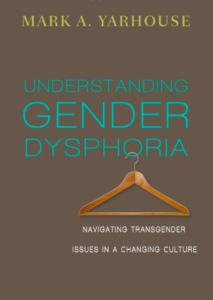Shame and Transgender Issues
I live in the Middle East, so we hardly ever hear conversations about transgenderism or sexual identity. So during a recent visit to the U.S., I observed how transgenderism and sexual identity have grown more prominent in cultural conversations.

To help myself understand the issues, I read Mark Yarhouse’s Understanding Gender Dysphoria: Navigating Transgender Issues in a Changing Culture (IVP Academic 2015). The book had more scientific research than expected, and yet was very helpful. Yarhouse explains the transgender experience and sets forth a Christian response. The issue of shame surfaced throughout the book. Here are some of the salient insights.
The Issue
Developing children look into the world and compare themselves to others. They try to see, “Who am I like? Who am I unlike? What group do I belong to?” But gender dysphoric people feel different on the inside. People say they are a boy, but all their internal feelings make them feel like they are not part of that group. They do not see themselves in terms of preferences and personal choices, but in terms of identity—I am not one of these people (pp. 71-72).
These involuntary feelings of gender difference create massive shame—“There is something wrong with me. I am not normal.” Naturally people hide this feeling, and feel like they have to “hide and cover themselves.”
People with gender dysphoria are mostly seeking community and identity—Who am I? Where do I belong? They are not seeking wild sexual fantasies or to ignore all social conventions. They want what all people want—a communal identity.
The Common Church Response
The churches’ response is often reductionistic—“That is sinful and you are being disobedient to feel that way. You must accept traditional gender roles of your birth sex. This will bring joy and peace. If not, you are sinning.” The message here is “you a shameful abomination.” Yarhouse says, “This is the formula for shame” and the reason why people turn away from the church (p. 46).
People then turn to the transgender community to fight that experience of shame. People accept them for who they “truly are.” People then say, “I am transgender” (identity) and “I’m part of the transgender community.” This group finally allows the gender dysphoric person to be with other similar people, often for the first time. Here they feel normal, not strange. At this point such people have little interest in Christianity.
So, if this is the common course of events, what are other approaches?
Other Responses
Yarhouse plots three main frameworks to transgender issues, and explains how Christians need to integrate the best of each approach.
- Integrity Framework—The maleness and femaleness of our bodies is sacred, and we must conform to God’s designation (Gen 2:21-24). We cannot deny the integrity of our sex. This approach upholds truth and holiness.
- Disability Framework—Gender dysphoria is a mental health issue, like PTSD or bi-polarism. This is a result of living in a broken world after the fall. This approach provides compassion and empathy.
- Diversity Framework—Any gender identity is to be honored and celebrated—this is just who you are, the way you were born. People have the right to define and express themselves. This approach offers identity and community.
Christians should offer people with transgender feelings (1) sacred truth, (2) genuine compassion, and (3) communal identity. Culture wars have polarized the issue, and so people assume that any offer of community and identity (Diversity Framework) compromises sacred truth (Integrity Framework).
Yarhouse says, “Any attempt at intervention in adolescence and adulthood would benefit from reflecting a meaning-making structure that informs identity and locates the person within a broader community of support. This community would function as a kind of kinship network (family) that affirms their worth and insists on navigating the terrain together, even when decisions may be quite complex and challenging to all involved” (p 124). A sense of tangible, communal honor is essential to overcome the years of feeling shameful and help move towards wholeness.
So instead of insisting people behave according to traditional gender roles, “a missional church focuses on first being in relationship (belong) and then moves toward an opportunity to live one’s testimony to an unbelieving culture (believe)” (p 147). Then in the context of that relationship people grow in their relationship with Christ (become/behave).
Conclusion
 Yarhouse often repeats gender dysphoria is complex and varies person to person, so avoids offering a uniform solution or comprehensive model for pastoral care. But even so, Christians benefit from better understanding the topic and having an integrated framework that informs our Christian engagement. Towards that end, I benefited from Yarhouse’s book (though I was surprised by his degree of openness for gender reassignment surgery for Christians).
Yarhouse often repeats gender dysphoria is complex and varies person to person, so avoids offering a uniform solution or comprehensive model for pastoral care. But even so, Christians benefit from better understanding the topic and having an integrated framework that informs our Christian engagement. Towards that end, I benefited from Yarhouse’s book (though I was surprised by his degree of openness for gender reassignment surgery for Christians).
Overall, Understanding Gender Dysphoria does a good job of unpacking the human aspect of transgender issues, especially the pivotal role of shame, identity, and community.
After writing and scheduling this post, I learned about this new book Affirming God’s Image: Addressing the Transgender Question with Science and Scripture by J. Alan Branch, so wanted to mention it as well for those interested.

Thanks for this thoughtful piece on a complex and challenging topic for the church and other faith communities. I did want to point out what I
believe is one typo of omission: Based on the the subsequent sentence (“They want what all people want—a communal identity.”) and the tone of the piece, I believe you mistakenly ommited the word “not” from the sentence “They are ___ seeking wild sexual fantasies or to ignore all social conventions.” It makes a big difference in the argument!
Thanks, corrected.
If you’re interested in this topic, please check out resources from Restored Hope Network and Pure Passion’s documentary Tranzformed (you can watch it for free on YouTube). Yarhoise has been getting a bit too liberal for my taste in recent years.
I have a daughter who has gone through the transgender progression. I also have read Yarhouse’s book and think this one and his other book on homosexuality are among the best. There are not simple solutions here, and as I have gone on a journey with my own child recognize that the pain is very real, and for most has persisted for a very long time. Often the church simply gives prescriptive advice without acknowledging the pain. I do believe we are called to love even when we are confused on the topic. There is a tendency to sit passively because we don’t want to make a mistake, but I think we are called to love and engage, and take the risk of “mistakes”.
Thank you for this. I need to learn so much.
As far as I understand, Yarhouse rejects the diversity framework. But this does not come through in your review. Please check.
I think the Psalms give us a model of expressing our emotions to God, where we can recognize that our desires and raw feelings may be foolish and sinful, but that we need not feel ashamed for having those desires.
I think this is what the Gospel offers as an identity framework for those with transgender desire, or same sex desire, or heterosexual desire outside the limits God has inspired. We all to varying degrees feel desires that are not what God intended, we can and should admit those desires to God, and ask for his help and wisdom to not give in to them.
In this issue, Shame, or Identity Confusion is key. Biblically, Shame is a loss of Identity and Inheritance. As a retire Therapist it is a foundational problem that underlies many of our anxieties and issues including Gender.
I first saw it in a young woman that was convinced she was, at 80 pounds, too fat. She suffered from anorexia or “Body Dysphoria”. Her brain distorted reality about her body.
Same sex attraction has similar distortions as do many problems that bring people to Therapy.
The rejection of Therapy and the issue of Shame by many fundamentalists, including George my own childhood church, hampers getting or giving help because Sin is seen always as Trespasses not deep brokenness. Understanding the difference between Emotional and Theological Shame is essential but not easily realized.
The Mental Illness and Medical Illness people react against traditional norms and promote radical treatments designed to forever alter the body tp conform to the child’s irrational ideas. Like the Prefrontal Lobotomies given to thousands of confused patients these treatments will haunt us forever.
We who know how to help strugglers must step up our game and move on from theory to practice. May God use these writings to empower Christians to stop emotional shaming and develop compassion for the broken-hearted to set the captives free.